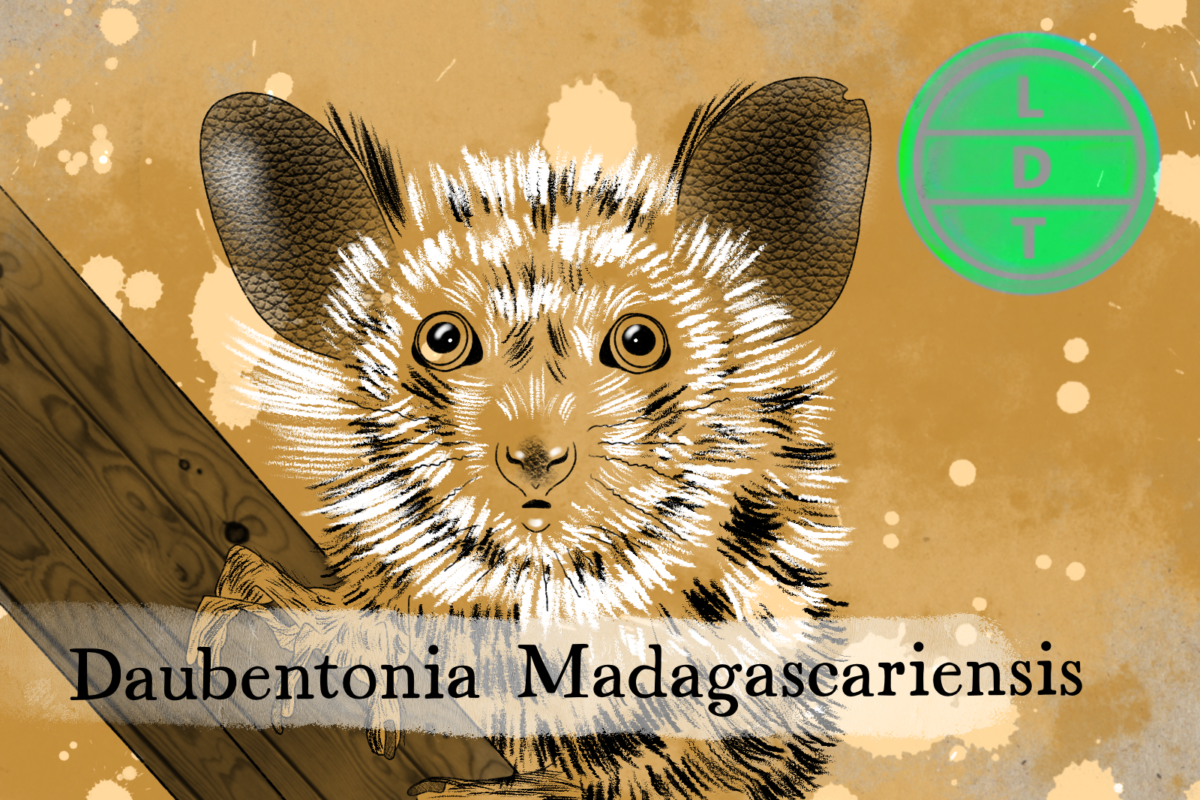“…and today we’re talking about a primate with its finger on the pulse of the forest. But more on that later.”
Once upon a drizzling Madagascar night, a small insect awoke, focusing his sight.
While nestled safe in his place of bamboo peace, a sound disturbed him and it would not cease.
All of a sudden there came a knock at the door. Who could it be at this hour of snores?
“Tis some visitor,” he said as he tucked back in. “You’d better stop this rude evening din!”
Just then, through a hole came a serpentine digit. It grabbed up the bug without a fidget.
The Aye Aye, without even being offered tea, ate well in Life, Death, and Taxonomy.
Description of the Aye Aye
- Looks like a crack-addled bat mouse
- It’s a lemur with a long tail and lanky legs
- One of its most distinguishing features is their long and bony fingers and toes that look like the evil mom’s hands from Coraline
- Its mousey face is rimmed with two large round ears like a certain mouse that’s managed to systematically murder every fanchise I’ve come to love.
- Its eyes are large, yellow, and wide open like a demon that’s been startled.
- Its body is covered in course, wiry brown, silver, and black fur, so it definitely looks like something that would carry a village’s children off at night. Ripe for folk superstition, which we’ll see in a bit.
Measure Up
Welcome to the beloved Measure Up segment. The official listener’s favorite part of the show! The part of the show when we present the animal’s size and dimension in relatable terms through a quiz that’s fun for the whole family. It’s also the part of the show that’s introduced by you when you send in audio of yourself saying, singing, or chittering the words Measure Up into ldtaxonomy at gmail dot com. We don’t have a new Measure Up intro!
Length
- 36–43 cm (14–17 in)
- How many longhorn beetle larvae go into the length of the Aye aye?
- Hint: The Longhorn beetle is a black and yellow beetle of madagascar and its larva is a favorite food of the aye aye. It gets its name from its antennae, which can be longer than its body length.
- 1.9 larva. The larva is 0.5 to 22 cm (8.6 inches) long.
Weight
- 2 kilograms (4 pounds)
- How many aye ayes would a fossa have to eat to eat its weight in aye ayes?
- Hint: The fossa is the aye aye’s only natural predator. It looks like a cat but it’s not in the Felidae family. Instead, it’s in a family of ten living species that are exclusive to Madagascar.
- 5.2 aye ayes. The fossa is 9.5 kg (21 lbs).
Fast Facts about the Aye Aye
- Range: The rainforests of Madagascar
- Diet: Insectivorous. Also loves seeds, nuts, fruit, nectar, fungi, and even honey.
- Behavior:
- They live their whole lives in trees. They sleep in nests high in the rainforest canopy during the day and spend 80% of the night foraging for food.
- Only primates that use echolocation
- They are solitary and only really get together to mate
- Their territories can be as much as 20 acres, which they delineate by rubbing scent from their cheeks and necks on trees.
- The Malagasy people actually see these guys as bad omens and harbingers of evil and are killed on sight
- Whoever they point to is marked for death
- Some people believe that the aye aye sneaks into homes and punctures people’s aorta to kill them
Major Fact: Finger on the Pulse
Aye ayes have an enormous middle finger, that’s different from all of their other fingers. The third finger on both of their hands is long and thinner than the other digits.
Not only is it shaped differently, it is also more flexible. It has a ball and socket metacarpophalangeal joint, which is the joint at the top of your palms that make the meat of your knuckle sandwiches.
A ball and socket joint is like your shoulder or hip, which can move circularly, while hinge joints can only bend and straighten.
This long, flexible finger is used in several ways. It’s most notably used in hunting and foraging.
Aye ayes are the only primate known to use echolocation and they use a particular kind of echolocation called percussive foraging. The use their fingers to tap on tree branches and bamboo and listen for an echo that indicates there is a hollow area where bugs might be.
Then they use their forward facing incisors to cut a hole in the bark, through which they insert their slender digit. When they reach a grub, they will use a hooked claw to pull it out and dine like Simba. They may also use their fourth finger, which is very long and has more muscle to pull grubs out.
However, that’s not the only kind of opening they link to pull tasty snacks out of.
Aye ayes are pickers, but they aren’t flickers. They will use their long and skinny fingers to reach into their nostrils and pull out fresh nostril fruit to eat. According to our friends at the BBCs Discover Wildlife Magazine, their fingers can reach all the way to their throat through the nostril.
Ending: So scrounge around in your orifices, keep your eyes disturbingly wide open, and give your food the finger like the aye aye here in LDT.

